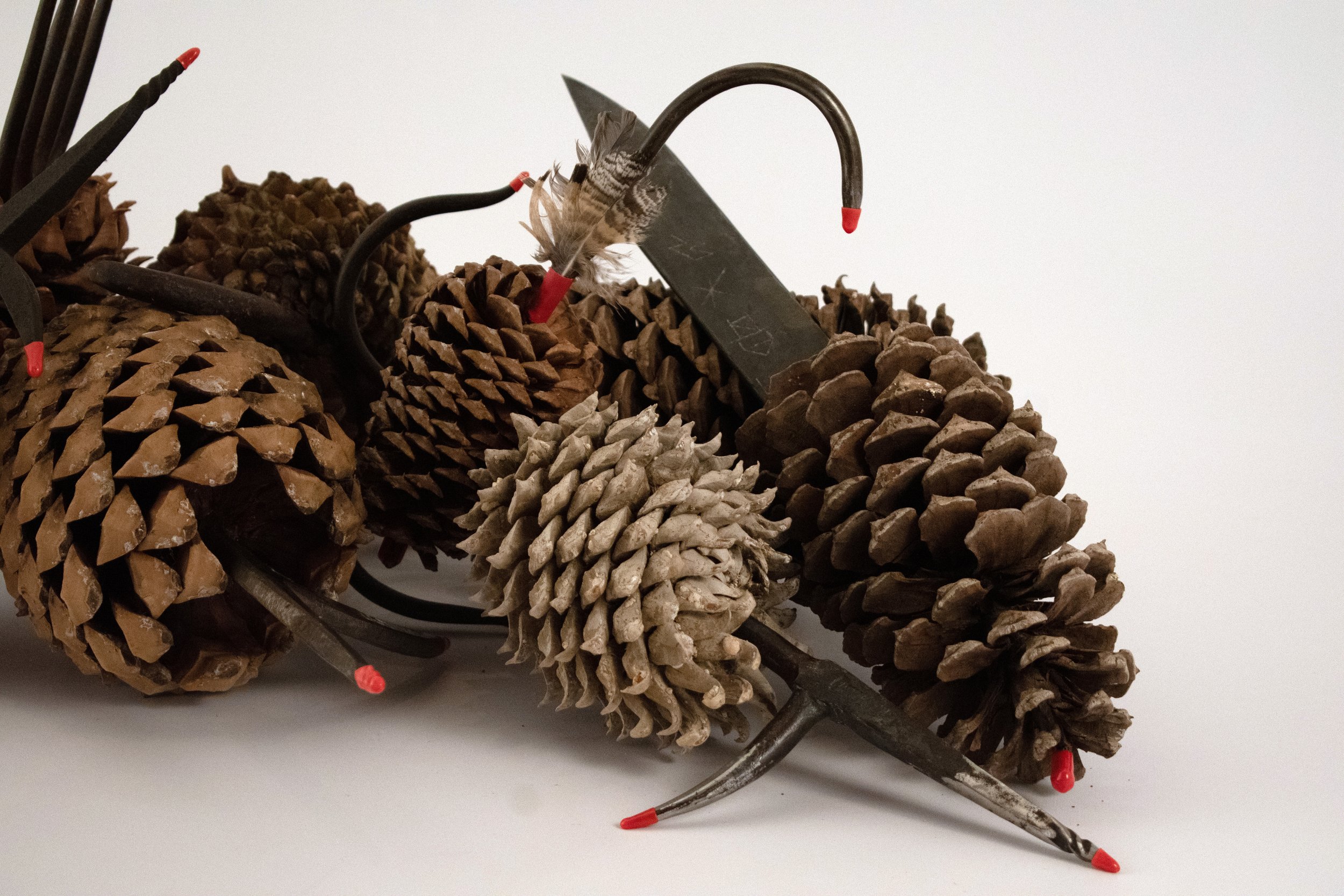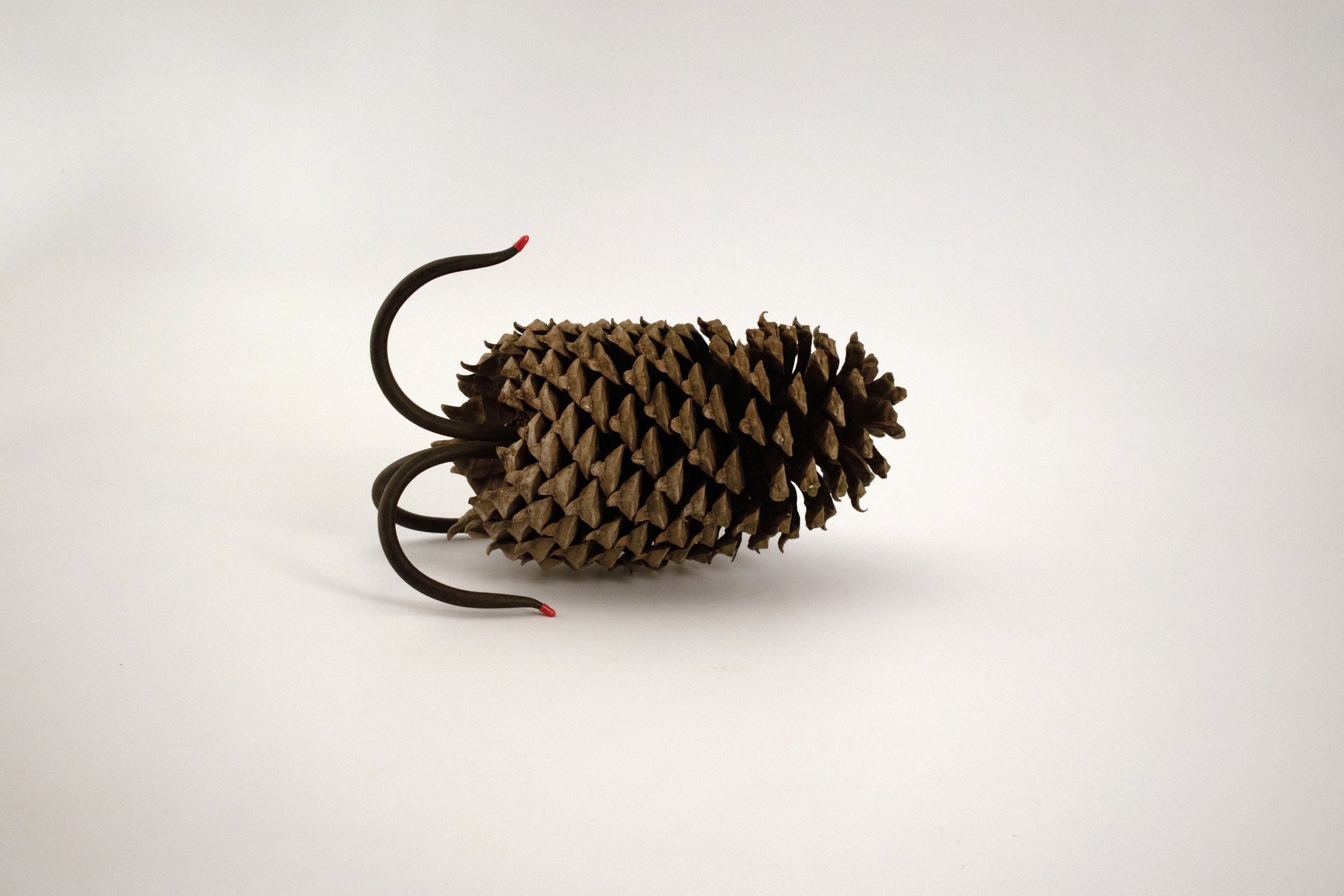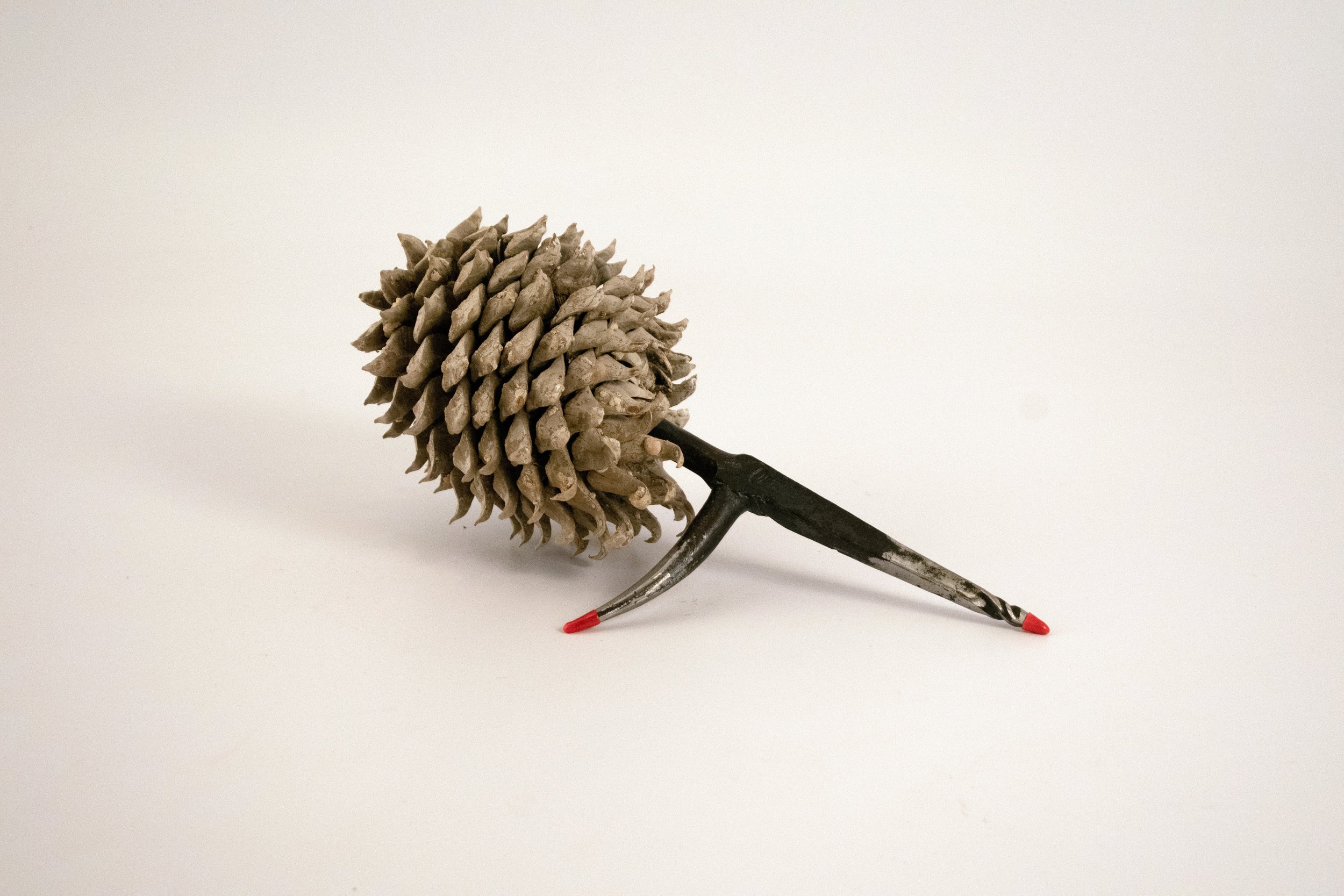Arboreal Goth Collection
Collections are common across all cultures, especially in the West in the waning age of late capitalism. Collections of cultural objects (man made things) can represent conspicuous consumption, wealth, and excess, and have so since the rise of the Middle Ages’ merchant class. On the other hand, botanical collections can represent a rich knowledge and pedagogical opportunity for environmental understanding; specifically, the knowledge of endemic plant narratives and natural histories that are embodied in both individual specimens and the collection as a whole.
Most naturalists agree that all living organisms possess eons of evolutionary backstory—every plant characteristic tells a story of survival. Some of these histories are clearly evident in formal details, such as the hook-shape of a pine cone scale. Other stories only present themselves upon rigorous research, such as the presence of nanoplastics in eukaryotic cells of the Pinus sabiniana ‘Tines’ cultivar, commonly known as the “spork pine.” That said, every specimen in the Arboreal Goth Cone Collection is no mere cone, but a story of evolution, adaptation, and resiliency. A resiliency that is ever more remarkable, and frankly worthy of scholarly documentation, in the contemporary context of our shrinking biota.
The Arboreal Goth Cone Collection took years’ of plant expedition planning, miserable field research management, grueling grant writing, and tedious lab analysis. Still, the toil has been rewarded—the cone collection captures some of the most extraordinary Pinus sabiniana (foothill pine) cultivars ever created in North America. The significance of the collection is more than a curated group of freakish gymnosperms and arboreal oddities, but a rich volume of ecological lore articulating the complicated relationship between the humans and trees of North America. Moreover, this collection is outstanding in that many of the cultivars were arguably created with the intention of profit and material gain at the expense of native cone-bearing species—a monstrous motivation that is truly ghoulish in the context of our dying global ecosystem.
The ever-growing Arboreal Goth Cone Collection currently includes the following: Pinus sabiniana ‘Uncinus,’ Pinus sabiniana ‘Forksis,’ Pinus sabiniana ‘Impaler,’ Pinus sabiniana ‘Uncinus,’ Pinus sabiniana ‘Barbus,’ Pinus sabiniana ‘Pike Alba,’ Pinus sabiniana ‘Umbra Alba,’ Pinus sabiniana “Tines,’ Pinus sabiniana ‘Grapnelia,’ and Pinus sabiniana ‘Granada.’
Pinus sabiniana ‘Barbus’
Pinus sabiniana ‘Barbus’ commonly known as the “barb pine” or “sloth hooker,” is considered to be an arboreal anachronism. The umbos of the cone evolved along with the giant ground sloths, including Megalonyx, who were widespread in North America up to the Wisconsin Ice Age. The barbed pinecone adapted to attach to the sloth’s wooly coat in order to spread its seeds over a long-range as the sloth would walk great distances in search of food. As land sloths slowly went extinct, early humans learned to cultivate the barbed pine specimen for its unique velcro-like characteristic and use as a practical joke during tedious hunting trips.
Pinus sabiniana ‘Anglerus’
Pinus sabiniana ‘Anglerus’ commonly known as the “lure pine,” is a medium-sized pine cultivated for its appearance of an oversized fly fishing lure. It is endemic throughout North American riparium systems and most often found in fancy glass display cases in overpriced outfitter showrooms in bourge ecotourism hotspots, i.e., Jackson, WY. Note: the dyed turkey feathers are an aftermarket phenomenon that is generally frowned upon within serious collector circles.
Pinus sabiniana ‘Forksis’
Pinus sabiniana ‘Forksis,’ commonly known as the “pitch fork pine” is a small-to-medium-sized pine. It is native to western North America, primarily from British Columbia to northern California and as far east as Idaho. It is found in environments that most other tree species find unsuitable for growth, such as acidic, sandy soils, not to mention disturbed landscapes of political unrest and cultural upheaval.
Pinus sabiniana ‘Whack Bat’
Pinus sabiniana ‘Whack Bat,’ commonly known as the “grenade pine,” is the most common seed bomb cultivar found west of the Rocky Mountains in North America. The oblong cone with its single stem pin and large ring is rumored to be the inspiration for the fictitious game of “whack bat” in the 2009 cult classic film Fantastic Mr. Fox. As a result of the Andersonian association, the Whack Bat pine strobili are bona fide trophy cones. Caveat emptor; unscrupulous cone traders have been known to pass off the common “ringworm pine” cone (easily identified by its double stem pin) for the premium price of a Whack Bat cone. Nihilo sanctum estne?
Pinus sabiniana ‘Grapnelia’
Pinus sabiniana ‘Grapnelia,’ commonly known as a “grappling foothills pine” or “gray batman hook pine” is a large-sized pine tree endemic to California and Southern Oregon. The tree is easily identified by its sharp spiny cone and grappling hook-like terminus. The cone, about the size of an American football, is spiked, relatively heavy (up to six kilograms), and a known “public safety hazard” during even mild wind events. Despite the cone’s dangerous reputation, dendrophiles are seduced by the cone’s remarkable appearance and size (up to 35 cm). The cones are often found in collections of amateur niche naturalists, affectionately known as “Cone Heads.”
Pinus sabiniana ‘Impaler’
Pinus sabiniana ‘Impaler,’ commonly known as the “river pike pine” is a medium-to-large-sized pine native to eastern and western North America, from Nova Scotia to New York in the east and British Columbia to Northern California in the west. It is found in cool riparian valley systems and is associated with the river log drive of the 19th and 20th Century lumber trade in North America. Notwithstanding its industrial past, the tree’s iconic cone is prized by tree-huggers for its sharp uni-terminal pike-pick point which is covered in a red plastic cap per safety code.
Pinus sabiniana ‘Tines’
Pinus sabiniana ‘Tines,’ commonly known as the “spork pine,” is a medium-to-large sized pine cultivated for its tolerance of dry urban environments. It is native to North America and is typically found to the left of the salad fork.
Pinus sabiniana ‘Umbra Alba’
Pinus sabiniana ‘Umbra Alba,’ commonly known as a “white ghost pine” or “Winthrop pine,” has a portentous origin. Legend has it that this pine with its white colored cone (actually kind of sickly pale yellow in appearance) descends from the first tree chopped down by colonial Puritans on June 6th, 1630 AD (citation needed). Only found in cultivation today, the ghost pine is said to have been collected from a singular stump in the Massachusett region in the late 1600’s and is consequently considered a haunting ecological reminder of the Great Puritan Migration.
Pinus sabiniana ‘David Bowie’
Pinus sabiniana ‘Tines,’ commonly known as the “spork pine,” is a medium-to-large sized pine cultivated for its tolerance of dry urban environments. It is native to North America and is typically found to the left of the salad fork.
The Arboreal Goth Cone Collection is an ongoing speculative-design project exploring gothic hybrids of ecology, industrial material, collector culture, and late-capitalism in North America. The original concept stems from an obscure pine cone art form practiced by lookout personnel stationed in wildfire watchtowers throughout the Pacific Northwest. The series is intended to tell human stories of declining ecological systems. The fictitious collection foregrounds an environmental legacy characterized by misguided resource management and lack of ecological awareness.
The mixed-media objects are created from old logging tools, pine cones, macro plastics, oil-based paints, and natural oils and waxes. Dimensions vary by cultivar.
Collaborators: David Buckley Borden, Nancy Silvers, and Ian Vierck
This work is funded by the Fuller Initiative for Productive Landscape at the University of Oregon, Oregon State University Foundation’s Andrews Fund, and the sale of artwork on DBB’s website.











